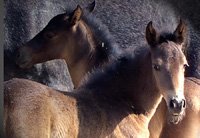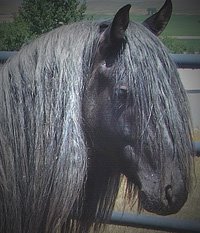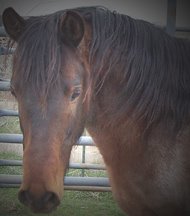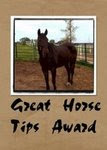Many trainers emphasize the importance of extensive repetition to equine learning. In his books, John Lyons recommends counting 50 or more repetitions of a single exercise, such as the "go forward" cue, on the theory that a horse won't fully understand what he's doing right without that much practice.
I respect many things about John Lyons (not least, his marketing ability) but endless repetition is a point on which we disagree. If I tapped Consolation's hip an
 d asked her to go forward, then stop, then go forward, then stop 50 times, she'd kick me from here to Rhode Island... and I'd deserve it.
d asked her to go forward, then stop, then go forward, then stop 50 times, she'd kick me from here to Rhode Island... and I'd deserve it.Note: That's our Barb filly Ripple Effect in the photos, during her first lunging lesson in November 2007.
Perhaps breed is a key factor in the debate. Lyons' longtime star performer was an Appaloosa called Zip. Lyons is almost always pictured aboard Quarter Horses or breeds of similar type, as are other riders featured in his books and DVDs. Quarter Horse types, on the whole, come standard with a different kind of mind than Barbs, Arabians, and other hot bloods.
Quick history lesson: Most of the horses brought to the New World beginning with Columbus' second voyage in the late 1400's were small, hardy, hot blooded Spanish stock. For years, many colonists and American Indian tribes bred superior horses of a type commonly referred to today as "Spanish Colonial." It was astride some of our Barbs' ancestors that Chief Joseph's Nez Perce tribe outran the U.S. Army for nearly 2,000 miles in 1877.
Sadly, the Army failed to recognize the quality of these flashy-coated but small horses. Upon Chief Joseph's surrender, most of the Nez Perce's stallions, like those of many other tribes, were gelded or shot. Draft and thoroughbred stallions were turned out in their place in hopes of improving upon the tough, little mares.
While the Spanish Colonial type still reigns in South America, we North Americans have become unaccustomed to them. My neighbor with the bay mare wasn't the first to comment, albiet in a non-disparaging tone, that my Barbs "don't look like normal horses."
Indeed, today's Quarter Horses and their colored cousins, the Appaloosas and Paints, are heavily influenced by the extensive cross-breedings that nearly wiped out the Spanish Colonial type in North America. These breeds include a number of fine individuals, but on the whole they reflect the cold blood of their draft ancestors not only in their bulky, fast-twitch muscle fibres, but also in their relatively lethargic mentality.
Many equestrians, like Lyons, prefer Quarter Horse types for their muscular physique and quiet demeanor. There's something to be said for a horse that will tolerate a great deal of abuse, whether intentionally in the form of "cowboying" or unwittingly by careless or novice riders. With this advantage, however, comes thicker skin -- figuratively and sometimes literally -- that requires more repetition before a lesson breaks through.
 Our Barbs, however, learn so quickly that one or two repetitions is often sufficient. My usual training tactic is to make a request, reward attempts at the right answer, repeat the behavior several times to be sure the horse understands, then move on to something else and review the lesson later. Lingering too long on a single task results in a bored and frustrated horse. I can almost hear such an animal thinking, "I've got it, lady. Lay off."
Our Barbs, however, learn so quickly that one or two repetitions is often sufficient. My usual training tactic is to make a request, reward attempts at the right answer, repeat the behavior several times to be sure the horse understands, then move on to something else and review the lesson later. Lingering too long on a single task results in a bored and frustrated horse. I can almost hear such an animal thinking, "I've got it, lady. Lay off."You know the familiar advice: Always finish on a good note. Too often, this is applied as follows:
1) Trainer frustrates horse by repeating the lesson too many times after horse "gets it"
2) Horse reacts by seeming to forget or rebel against the lesson he just learned
3) Trainer, also frustrated, continues drilling horse
4) Horse complies, but shoddily and with a poor attitude
5) Trainer quits, believing herself to have ended on a "good note"

I've done it.
Haven't you?
Blessed was the day I learned to stop just after the epiphany, when both horse and trainer are triumphant.
We did it, partner! We're brilliant together! Let's do it again tomorrow!









3 comments:
*Applause* I agree with this so much, I feel it deserves a standing ovation. A bored horse is not going to be receptive to learning.
This is a great post. VERY important point, I believe.
We humans tend to "educate" the way we were "educated," all by theory X. I think theory Y is the way to go.
A trainer I know, Don Warner, puts it very simply: "When you get what you want, stop asking."
There's a lot in common, training people and horses, and one thing is "Do new skills when you're fresh; don't try new things or practice them when you're mentally or physically fatigued."
Or a gambler might say, "Quit when you're ahead."
I think it is the frequency rather than the duration of training that has the best effect. Better to practice a few minutes, perfectly every day, than a longer session less frequently, during which time your performance deteriorates through fatigue or boredom.
I can't prove this but my observations over 30 years of teaching strongly suggest that students will remember best the last thing they do. I want that to be a "perfect" performance. And that's not likely to happen when they're burned out.
Just my opinion.
sj
Such a good point. I don't know about it being breed specific, as you suggest, though that might be true. But I know with my Morgan mare, who is very smart, that I am better off rarely repeating an exercise, because by the third time she figures she knows what I want and can do it herself! Even if we are "repeating" something til she gets it, like a certain transition, I mix it into different combinations of patterns and directions, so it is never exactly the same.
Nice post!
Post a Comment